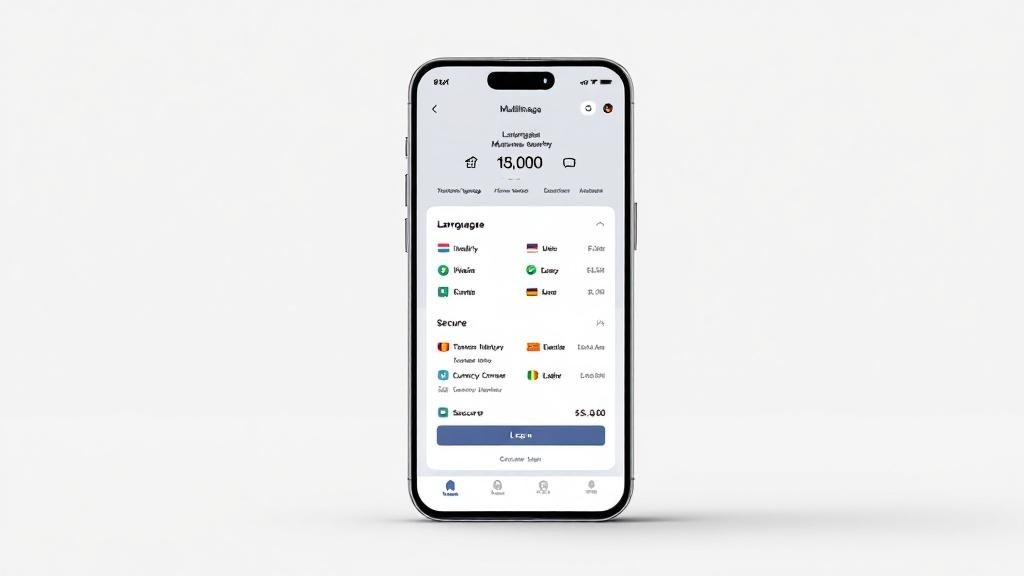In today’s fast-paced digital world, mobile banking has become an essential tool for managing finances. Whether it’s paying bills, transferring money, or checking your account balance, mobile banking apps offer a range of benefits that simplify our financial tasks. One of the standout features of modern mobile banking is the rise of multilingual mobile banking apps, which cater to diverse users globally.
In this article, we’ll explore the benefits of using mobile banking apps for multiple languages, and how these apps can enhance the banking experience for users from different cultural backgrounds. We will also dive into the significance of mobile banking solutions that support various languages, making banking accessible and efficient for a global audience.
Let’s look at how multilingual mobile banking apps are changing the financial landscape, and why you should consider adopting these apps for your everyday banking needs.
The Growing Need for Multilingual Mobile Banking Apps
Globalization and Digital Banking
As the world becomes more interconnected, the need for cross-border banking apps has never been greater. With more people traveling, working remotely, or doing business internationally, there’s an increasing demand for international mobile banking apps that provide language localization and multi-language support.
The idea is simple: if mobile banking apps are designed to cater to a wider range of people, users can have a more seamless experience. Mobile banking for non-English speakers is becoming a priority for banks worldwide. This is especially crucial for users in non-English-speaking countries or those who are more comfortable using a language other than English.
Enhancing User Experience through Language Customization
Language customization in apps can significantly improve the mobile banking user experience. When apps are tailored to different languages, users can navigate the app more intuitively and perform tasks with ease. A banking app with language localization ensures that instructions, menus, and customer service are available in the user’s preferred language, eliminating the need for translations and reducing confusion.
This approach is essential for users who may not be fluent in English. Whether it’s a secure mobile banking application or a cross-cultural user interface design, multilingual support plays a key role in making banking accessible for all.
Mobile Banking Apps: A Lifeline for Diverse Users
Today, people speak a multitude of languages, and ensuring banking app accessibility features for everyone is crucial. Mobile banking apps for diverse users allow individuals from various linguistic backgrounds to access banking services effortlessly. This inclusivity opens up new opportunities for banks to expand their customer base and serve global communities.
The Impact of Multi-Language Support on Global Banking
As the digital banking industry evolves, the ability to cater to global mobile banking platforms that serve a wide variety of users is becoming increasingly important. Whether you’re dealing with currency conversion in banking apps or international finance apps, the ability to switch between languages gives users flexibility and convenience, making the process faster and more user-friendly.
Key Benefits of Multilingual Mobile Banking Apps
1. Increased Accessibility for Non-English Speakers
A primary benefit of multilingual mobile banking apps is their ability to reach a broader audience. For non-English speakers, banking apps in their native language can remove the barriers of language and accessibility. Imagine a rural community in India where people may not speak English—multilingual banking solutions provide an effective way for them to access banking services.
2. Improved User Engagement and Satisfaction
When users can access banking apps in their language, they are more likely to engage with the app regularly. Language localization strategies help banks provide personalized experiences. Whether you are a tech-savvy millennial or a senior citizen, a mobile app with language options will enhance your experience and increase your likelihood of using the app consistently.
3. Faster and More Efficient Transactions
A mobile app language preference feature allows users to set the app to their language, speeding up the process of banking. Instead of relying on translations or using English as a default, users can access their accounts and perform transactions in the language they are most comfortable with, making banking smoother and more efficient.
4. Increased Trust and Transparency
Trust is a vital element in any financial service. When a bank provides services in the user’s native language, it shows that the institution values its customers’ needs. This trustworthiness is reinforced, especially in cross-border banking transactions where users may be more cautious about international dealings.
5. Regulatory Compliance
Certain countries have regulations that require financial institutions to offer services in the official language(s) of the region. Mobile banking apps with language localization help banks meet these legal requirements, ensuring they comply with local laws, which is crucial for maintaining customer trust and avoiding penalties.
How Multilingual Mobile Banking Apps Work
User Interface (UI) and User Experience (UX) Design
Creating a cross-cultural user interface design for a mobile banking app requires a deep understanding of cultural preferences and language intricacies. In some cultures, people read from right to left, and the layout must be adjusted accordingly. Additionally, fonts, icons, and colors may need to be customized to appeal to different audiences.
Real-Time Translation and Multi-Language Options
Many international mobile banking apps today come equipped with real-time translation features, allowing users to seamlessly switch between languages. This is especially useful for currency conversion in banking apps or managing international accounts. The language options are often set during the onboarding process, making it easy to tailor the app to personal preferences.
Securing Multilingual Banking Apps
Security is paramount in banking apps, and it becomes even more critical when dealing with multiple languages. To ensure that mobile banking apps are safe for users worldwide, banks invest in advanced security measures, such as encryption and multi-factor authentication, across all language versions of their app.
How to Choose the Right Mobile Banking App with Multilingual Support
1. Look for Popular Banking Apps with Language Options
Several global banks now offer mobile banking apps with multi-language support. These apps cater to users from different regions and offer services in various languages. Some popular options include apps like PayPal, Revolut, and HSBC, which have strong language localization features for users across the world.
2. Check for Localized Customer Support
A great multilingual mobile banking app doesn’t just offer language options for the user interface—it should also provide customer support in various languages. Whether you need help with your account or are facing a technical issue, having a multilingual support team can make all the difference.
3. Ensure the App Supports Your Preferred Languages
Not all mobile banking apps offer the same level of multilingual support. Ensure that the app you’re considering supports the languages you use most frequently. You might want an app that supports regional dialects, for example, in addition to widely spoken languages like English, Spanish, or French.
4. Check Security Features
As with any banking app, security should always be your top priority. Choose a multilingual mobile banking app that prioritizes secure mobile banking applications, especially when dealing with sensitive financial information and international transactions.
FAQs About Multilingual Mobile Banking Apps
1. What are multilingual mobile banking apps?
Multilingual mobile banking apps are banking applications that offer language options to cater to users from different linguistic backgrounds. These apps enable users to choose their preferred language for a better banking experience.
2. Why is language localization important in banking apps?
Language localization ensures that users can navigate and use the app in their native language. This makes the app more accessible, improves user engagement, and boosts customer satisfaction by catering to diverse cultural and linguistic needs.
3. What is the best mobile banking app with language options?
Popular apps with language localization include Revolut, PayPal, and HSBC, which offer multiple language options for users around the world. Always choose an app that supports your preferred language and offers the features you need.
4. How can multilingual support improve the mobile banking experience?
Multilingual mobile banking apps provide a more personalized experience, reduce the likelihood of user errors, and ensure that users can access features in their own language, improving their overall banking experience.
5. Are multilingual mobile banking apps secure?
Yes, most secure mobile banking applications are designed to offer the same level of security across all language versions. They employ robust encryption, multi-factor authentication, and other security measures to keep user data safe.
6. Can I change the language in my banking app?
Most modern mobile banking apps allow users to change the language from the settings menu. You can select your preferred language at any time, ensuring that your app experience remains comfortable and intuitive.
7. How do multilingual banking apps handle currency conversion?
Many mobile banking apps with language options offer currency conversion features that are automatically adjusted according to the user’s selected language and region. This helps streamline international transactions and makes cross-border banking more efficient.








Comments (0)